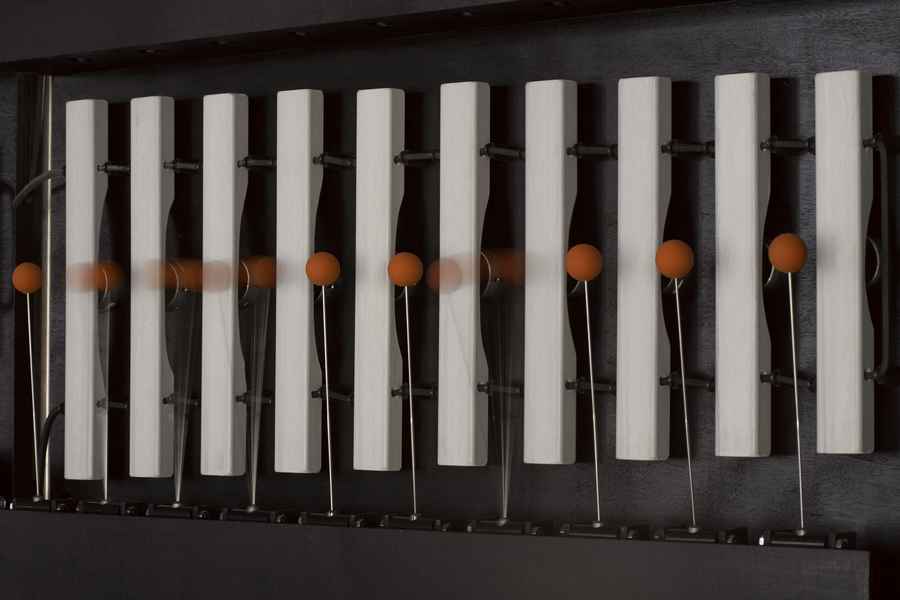Metaphone
Percussions
Europe
Between 1901 and present
Video
The Metaphone is a unique and relatively lesser-known musical instrument that blends elements of percussion and electronic synthesis to produce a diverse range of sounds. It is classified as an electroacoustic instrument, meaning it uses both acoustic and electronic components to generate and modify sound. The instrument is designed to create a balance between mechanical sound production and digital sound manipulation, allowing musicians to explore a broad spectrum of sonic textures.
In terms of physical construction, the Metaphone often consists of resonant metal plates, wooden bars, and electronic actuators. These components are either struck manually or activated through programmed sequences, resulting in a blend of organic and electronically modified tones. The integration of digital processing enhances the instrument’s ability to produce rich harmonics, modulate frequencies, and create rhythmic variations, making it a versatile tool for experimental and contemporary music.
The Metaphone is generally classified under hybrid instruments due to its dual nature. It falls into the category of idiophones when considering its percussive elements, while its electronic modifications align it with synthesizers. This combination allows musicians to achieve an expressive range of sound that is not easily attainable with conventional acoustic instruments.
History and Origin
Continent of Origin
The Metaphone, as an innovative musical instrument, does not have deep historical roots like traditional instruments such as the violin or piano. Instead, it is a modern invention that has emerged from advancements in electronic music and experimental sound design. The origins of the Metaphone can be traced back to Europe, where experimental musicians and instrument designers sought to create new means of sound expression.
Century of Invention
Unlike classical instruments that date back centuries, the Metaphone is a product of the late 20th and early 21st centuries. Its development aligns with the growing trend of merging traditional instrument mechanics with electronic sound manipulation. The rise of digital music production and the increasing interest in electroacoustic music in the late 1900s contributed to the conceptualization and refinement of the Metaphone. Innovations in music technology, particularly in the field of sound synthesis, played a crucial role in shaping the instrument into its present form.
Types and Features
The Metaphone exists in several variations, each catering to different musical needs. Though it is not as widely classified as traditional instruments, it can be distinguished based on its mode of operation and features.
Acoustic-Electronic Metaphone This type retains more acoustic characteristics while incorporating electronic modifications. It consists of a primary acoustic structure, such as wooden bars or metal plates, that are struck to produce sound. Electronic elements such as sensors and actuators are then used to enhance the sound output, adding reverb, modulation, and pitch alterations.
Fully Electronic Metaphone This variation eliminates acoustic components and relies entirely on electronic signal generation and digital processing. It operates using MIDI controllers, synthesizers, and sound libraries, allowing musicians to manipulate tones digitally. The fully electronic Metaphone is often used in experimental and ambient music.
Hybrid Metaphone This type combines acoustic, mechanical, and digital elements in a balanced manner. It features both manually playable components and programmable elements that allow for automated sound sequences. This hybrid approach makes it highly versatile for composers and live performers.
In terms of features, the Metaphone often includes:
- Variable Pitch Control: Allows musicians to alter the pitch dynamically.
- Resonance Modulation: Enhances tonal depth and harmonic complexity.
- Programmable Sequences: Enables automated and loop-based performances.
- Touch and Motion Sensitivity: Some versions include interactive elements that respond to gestures and pressure.
Work Mechanics
The Metaphone operates through a combination of physical interaction and digital processing. Depending on the type of Metaphone, it may require direct manual engagement, programmed instructions, or a combination of both to produce sound.
For acoustic-electronic variants, sound is generated when the musician strikes or taps the resonant components, such as metal plates or wooden bars. These vibrations are then captured by sensors, which relay the signals to a digital processor. The processor applies various modifications, including delay effects, frequency shifts, and amplitude modulation, before amplifying the output through speakers.
In fully electronic versions, the instrument functions similarly to a synthesizer. It relies on pre-programmed algorithms and touch-sensitive controls to generate sound waves. These waves can be shaped, filtered, and layered in real-time, allowing for intricate compositions.
Hybrid models use both manual performance and digital manipulation. The musician can play acoustic elements while the system records and processes the sounds in real-time, adding automated sequences to create dynamic performances.
Role in Music
The Metaphone plays a significant role in contemporary music, particularly in experimental, ambient, and electronic genres. Due to its ability to generate unconventional sounds, it is widely used in avant-garde compositions and sound art installations.
In live performances, the Metaphone adds a distinctive sonic dimension, allowing musicians to break free from the limitations of conventional instrumentation. It can be used as a standalone instrument or integrated into a larger ensemble, where it contributes unique textures and rhythmic structures.
In studio production, the Metaphone serves as a sound design tool, enabling producers to craft intricate soundscapes, cinematic effects, and innovative textures. Its versatility makes it an asset in composing for films, video games, and multimedia projects.
Significance
The Metaphone holds great significance in the realm of modern music due to its capacity for sonic exploration and innovation. Its hybrid nature bridges the gap between acoustic tradition and digital advancement, providing musicians with a tool that expands creative possibilities.
One of the key contributions of the Metaphone is its role in pushing the boundaries of musical expression. By allowing for real-time sound modulation, it enables artists to experiment with timbre, dynamics, and rhythm in ways that conventional instruments cannot. This has led to new forms of musical storytelling and immersive auditory experiences. Furthermore, the Metaphone represents the fusion of technology and artistry. It reflects the evolving relationship between musicians and digital interfaces, showcasing how electronic augmentation can enhance the expressive potential of an instrument. The ability to merge live performance with digital synthesis makes the Metaphone an essential tool for forward-thinking composers and performers.
In the broader context of music, the Metaphone contributes to the ongoing evolution of sound exploration. It aligns with the principles of electroacoustic music, emphasizing the interplay between organic and synthetic elements. This makes it a valuable instrument in academic research, experimental composition, and avant-garde performances.
FAQ
What are the unique characteristics of the Metaphone?
The Metaphone is a concert hall that also functions as an urban musical instrument. It features a unique exterior with vibrating plates and mechanical instruments, allowing it to produce sound in harmony with light. Its design combines architecture and music, making it a world-first in its kind. The Metaphone's ability to integrate sound with its surroundings creates an immersive experience for listeners.
Where did the Metaphone originate, and in which century was it developed?
The Metaphone originated in Oignies, France, as part of the 9/9bis project. It was developed in the 21st century, specifically in the early 2010s, by Hérault Arnod Architectes in collaboration with Louis Dandrel. The project transformed a former mining site into a cultural hub focused on music and sound.
How does the Metaphone contribute to music, and what types of performances does it host?
The Metaphone contributes to music by offering a unique platform for composers and musicians to create and perform innovative pieces. It hosts modern music events, allowing for both live performances and automated sound diffusion. The Metaphone's versatility makes it an attractive venue for a wide range of musical compositions and performances.
 Links
Links
References
Other Instrument
Categories



















